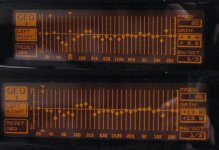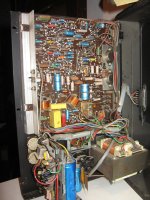Funny, in that little article (the old reprint), he covers just about all important points on the topic. A great primer on voice-coil derived MF.
But one curious error of omission. You can't use voice-coil derived MF on any suspension except a sealed box (and on a good day, maybe also open baffle). The reason for that actually illuminates one of the reasons some of us don't like any suspension except for sealed box (and maybe OB): in those other suspensions, there is no plain relation between cone motion and output... which sounds, to my ears, like an awful drawback.
BTW, a Klipschorn has a sealed box behind the cone which makes it sort of OK for voice-coil derived MF.
I haven't thought this through, but after reading the article, I realize there may be a correct woofer diameter where the you are driving the air, throughout the range of interest, with a falling radiation resistance due to small cone size. Not sure if that is like 10 inches or 30 inches....).
This thread has many readers, indicating wide curiosity. If you try voice-coil derived MF, you'll be amazed at how wonderful, broad, flat, tight, it makes the bass. But remember, when you traffic in new feedback loops, things can get loopy (and destructive). DAMHIK.
Ben
Last edited:
Hi
My job these days is to recap Philips mfb speakers RH544 which are 3 way. It is wery nice sounding speaker, beamped, with passive 2 way for mid n' hi band. Measuring with behringer rta from deq 2496, i got big negative spike-deep in curve (cca 10db), about 80 hz. for bass loudspeaker. This meaning, deq have to compensate this with giving more gain to that region. How to compensate this with some rc filter or something else? Original, not recaped one have same curve shape. Amp for this speaker is with condenser, 6800uF, only for bass, without any filter ...
Another problem (smaller, but) is positive spike-high (cca 6db) about 13 khz, in tweeter region. what to do with that?
Have to say, it is only measurement, speakers sound extraordinary, with deeep, almost stomach moving bass down to 30hz)
My job these days is to recap Philips mfb speakers RH544 which are 3 way. It is wery nice sounding speaker, beamped, with passive 2 way for mid n' hi band. Measuring with behringer rta from deq 2496, i got big negative spike-deep in curve (cca 10db), about 80 hz. for bass loudspeaker. This meaning, deq have to compensate this with giving more gain to that region. How to compensate this with some rc filter or something else? Original, not recaped one have same curve shape. Amp for this speaker is with condenser, 6800uF, only for bass, without any filter ...
Another problem (smaller, but) is positive spike-high (cca 6db) about 13 khz, in tweeter region. what to do with that?
Have to say, it is only measurement, speakers sound extraordinary, with deeep, almost stomach moving bass down to 30hz)
Attachments
Last edited:
Check my TAA article --- I did a simple motional feedback mod to an existing amp and showed the bass extension and distortion reduction. Worked well. Thx-RNM
[I'm out of the country and not able to tell you which issue]
Hi,
I will be pleased if you can tell it when back.
Regards.
(Post dating from last year)
But one curious error of omission. You can't use voice-coil derived MF on any suspension except a sealed box (and on a good day, maybe also open baffle). The reason for that actually illuminates one of the reasons some of us don't like any suspension except for sealed box (and maybe OB): in those other suspensions, there is no plain relation between cone motion and output... which sounds, to my ears, like an awful drawback.
Macaulay uses a positive feedback loop to generate a negative impedance at the output amplifier. The technique is very ancient and was somewhat popularised by Erik Stahl and then Yamaha. Albeit looking very similar, it is a bit different from a back-EMF derived signal from a Voigt bridge.
At the end of his AES paper, Stahl insists that this scheme is not real motion feedback as we usually understand it. The proof is that he used it with bass-reflex enclosures, where the sound output cannot easily be correlated with any kind of motion sensing, contraty to systems having a transfer function of a second order high pass filter (closed box and open baffle).
The nice thing with negative impedance it that it allows to modify the apparent value of the driver electrical damping, but this comes at a price : the difficulty of taming of the voice coil inductance which changes both with frequency and with its position in the gap.
Not sure I have the technical background to add much truth here but...
1. Sure, you can use VC MF with any box and might well sound better. But the right application is where the voice coil motion relates to the sound output (unlike boxes with resonances as major aspects of their sound like BR).
2. Often people publish stuff which they somewhat falsely claim is different from stuff that came before in order to be able to patent their own stuff. A lot of that in the history of MF.
3. You can have a bit of positive feedback but the net feedback sure has to be negative. As I poorly understand these things, with VC MF, you are increasing the output impedance with a positive loop but making the amp output impedance negative overall with negative feedback. In other words, you are creating an amp that looks (when looking backwards into it) as a 5-ohm resistor (going up and down parallel with the driver) rather than the usual +.01 resistor.
That may sound odd to the minds of some but, trust me, that's how the amp behaves. You just set up your lab bench to measure output impedance and low and behold, when you do the math you find the amp acts like a resistor but negative with the load. And at resonance where the driver is 35-ohms, the amp will be say, 15-ohms. Likewise, for any occasion where the cone makes an erroneous motion, the amp tries to undo it. And the amp "eats" room noise, I suspect.
4. The Philips speaker connects to a power amp which drives the mid and tweeter but it contains a power amp to work with the accelerometer to drive the woofer. A characteristic of MF (and maybe accelerometer) woofers is indeed their gut-punching tight bass (which is what makes their sound so very attractive as woofers), in addition to the frequency plot.
5. The extent of the changes in inductance as the voice coil moves or changes in resistance with voice coil temperature are factors which tend to be too small to fuss with, in my opinion. When I was fooling with Wheatstone Bridge circuits to derive voice coil MF, I never found it important to have the bridge simulate the driver electrical characteristics in anything but resistance in creating the no-signal balance of the bridge.
Ben
1. Sure, you can use VC MF with any box and might well sound better. But the right application is where the voice coil motion relates to the sound output (unlike boxes with resonances as major aspects of their sound like BR).
2. Often people publish stuff which they somewhat falsely claim is different from stuff that came before in order to be able to patent their own stuff. A lot of that in the history of MF.
3. You can have a bit of positive feedback but the net feedback sure has to be negative. As I poorly understand these things, with VC MF, you are increasing the output impedance with a positive loop but making the amp output impedance negative overall with negative feedback. In other words, you are creating an amp that looks (when looking backwards into it) as a 5-ohm resistor (going up and down parallel with the driver) rather than the usual +.01 resistor.
That may sound odd to the minds of some but, trust me, that's how the amp behaves. You just set up your lab bench to measure output impedance and low and behold, when you do the math you find the amp acts like a resistor but negative with the load. And at resonance where the driver is 35-ohms, the amp will be say, 15-ohms. Likewise, for any occasion where the cone makes an erroneous motion, the amp tries to undo it. And the amp "eats" room noise, I suspect.
4. The Philips speaker connects to a power amp which drives the mid and tweeter but it contains a power amp to work with the accelerometer to drive the woofer. A characteristic of MF (and maybe accelerometer) woofers is indeed their gut-punching tight bass (which is what makes their sound so very attractive as woofers), in addition to the frequency plot.
5. The extent of the changes in inductance as the voice coil moves or changes in resistance with voice coil temperature are factors which tend to be too small to fuss with, in my opinion. When I was fooling with Wheatstone Bridge circuits to derive voice coil MF, I never found it important to have the bridge simulate the driver electrical characteristics in anything but resistance in creating the no-signal balance of the bridge.
Ben
Last edited:
4. The Philips speaker connects to a power amp which drives the mid and tweeter but it contains a power amp to work with the accelerometer to drive the woofer. A characteristic of MF (and maybe accelerometer) woofers is indeed their gut-punching tight bass (which is what makes their sound so very attractive as woofers), in addition to the frequency plot.
Ben
Thanks, Marcus wrote maybe its the room. After changing position got much better results..

ps. Sorry for OFF TOPIC
Last edited:
- Status
- This old topic is closed. If you want to reopen this topic, contact a moderator using the "Report Post" button.
- Home
- Loudspeakers
- Subwoofers
- Motional Feedback Subwoofer
